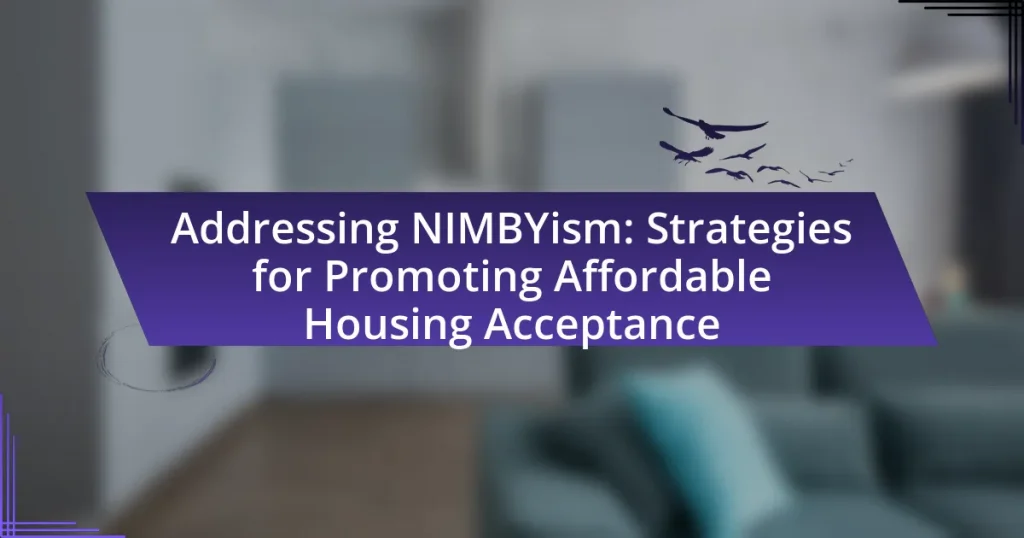Innovative financing solutions for affordable housing development encompass various mechanisms such as social impact bonds, community land trusts, and public-private partnerships. These solutions aim to address the affordable housing crisis by providing necessary capital and resources, overcoming challenges like insufficient funding and high construction costs. The article explores how these financing methods differ from traditional approaches, their role in promoting economic growth and sustainability, and the importance of stakeholder collaboration in implementing these strategies effectively. Additionally, it highlights future trends and the influence of technology and government policy on the evolution of financing options for affordable housing.

What are Innovative Financing Solutions for Affordable Housing Development?
Innovative financing solutions for affordable housing development include mechanisms such as social impact bonds, community land trusts, and public-private partnerships. Social impact bonds allow private investors to fund housing projects with the expectation of receiving returns based on the achievement of specific social outcomes, such as reduced homelessness. Community land trusts enable communities to acquire and manage land for affordable housing, ensuring long-term affordability and stability. Public-private partnerships leverage both public resources and private investment to develop affordable housing, often resulting in more efficient use of funds and resources. These solutions address the funding gap in affordable housing by combining various financial sources and aligning incentives among stakeholders.
How do these financing solutions address the affordable housing crisis?
Financing solutions address the affordable housing crisis by providing capital and resources necessary for the development of low-cost housing projects. These solutions often include mechanisms such as low-interest loans, tax credits, and public-private partnerships that incentivize investment in affordable housing. For instance, the Low-Income Housing Tax Credit program has facilitated the creation of over 3 million affordable housing units since its inception in 1986, demonstrating the effectiveness of targeted financial incentives in increasing housing supply. Additionally, innovative financing models like social impact bonds can attract private investment to fund housing initiatives, thereby expanding the available funding pool for affordable housing projects.
What specific challenges do these solutions aim to overcome?
Innovative financing solutions for affordable housing development aim to overcome the challenges of insufficient funding, high construction costs, and limited access to credit for low-income individuals. These solutions address the financial barriers that hinder the development of affordable housing by providing alternative funding sources, such as public-private partnerships and social impact investments. For instance, a report by the Urban Institute highlights that traditional financing methods often fail to meet the needs of affordable housing projects, leading to a significant gap in available units. By leveraging innovative financing mechanisms, these solutions can effectively mobilize capital and reduce the overall cost of housing development, making it more accessible to underserved populations.
How do they differ from traditional financing methods?
Innovative financing solutions for affordable housing development differ from traditional financing methods primarily in their flexibility and accessibility. Traditional financing often relies on rigid structures such as bank loans and government grants, which can impose strict eligibility criteria and lengthy approval processes. In contrast, innovative financing solutions, such as social impact bonds or crowdfunding, allow for more diverse funding sources and can adapt to the specific needs of projects, enabling quicker access to capital. For example, the use of community land trusts has been shown to facilitate affordable housing development by leveraging local resources and community engagement, which traditional financing methods typically overlook.
What types of innovative financing solutions exist?
Innovative financing solutions for affordable housing development include social impact bonds, community land trusts, and crowdfunding platforms. Social impact bonds are contracts with the government where private investors fund social programs and receive returns based on the achievement of specific outcomes, such as reduced homelessness. Community land trusts involve non-profit organizations acquiring land to develop affordable housing, ensuring long-term affordability and community control. Crowdfunding platforms allow individuals to invest small amounts of money in housing projects, democratizing investment and increasing access to capital. These solutions have been implemented in various regions, demonstrating their effectiveness in addressing housing affordability challenges.
What role do public-private partnerships play in these solutions?
Public-private partnerships (PPPs) play a crucial role in innovative financing solutions for affordable housing development by leveraging resources, expertise, and risk-sharing between the public and private sectors. These collaborations enable the mobilization of private investment to complement public funding, thus increasing the overall financial capacity for housing projects. For instance, in the United States, the Low-Income Housing Tax Credit program, which incentivizes private investment in affordable housing, has resulted in the creation of over 3 million affordable housing units since its inception in 1986. This demonstrates how PPPs can effectively address housing shortages by combining public policy goals with private sector efficiency and innovation.
How do social impact bonds contribute to affordable housing development?
Social impact bonds (SIBs) contribute to affordable housing development by providing upfront capital for projects aimed at improving housing stability and reducing homelessness. These financial instruments allow private investors to fund social programs, with returns contingent on achieving specific social outcomes, such as reduced emergency shelter use or increased housing placements. For instance, the Social Impact Partnership Act in the United States has facilitated SIBs that target homelessness, demonstrating that when measurable outcomes are achieved, government savings can be reinvested into further affordable housing initiatives. This model not only incentivizes effective solutions but also mobilizes private capital to address public housing challenges.
Why are innovative financing solutions essential for sustainable development?
Innovative financing solutions are essential for sustainable development because they provide the necessary capital to address complex social and environmental challenges. Traditional funding sources often fall short in meeting the growing demand for sustainable projects, particularly in affordable housing. For instance, the United Nations estimates that an additional $2.5 trillion per year is needed to achieve the Sustainable Development Goals, highlighting the gap that innovative financing can fill. By leveraging mechanisms such as social impact bonds, green bonds, and blended finance, stakeholders can mobilize private investment alongside public funding, ensuring that resources are allocated efficiently and effectively to promote long-term sustainability.
How do these solutions promote economic growth in communities?
Innovative financing solutions for affordable housing development promote economic growth in communities by increasing housing availability, which attracts new residents and businesses. When affordable housing options are expanded, it leads to a more diverse workforce, enhancing local economic activity. For instance, a study by the National Association of Home Builders found that building 100 affordable homes can create approximately 300 jobs and generate $28 million in local economic impact. This influx of residents stimulates demand for goods and services, further driving economic growth.
What environmental benefits can arise from affordable housing initiatives?
Affordable housing initiatives can lead to significant environmental benefits, including reduced urban sprawl and lower greenhouse gas emissions. By promoting higher-density living, these initiatives minimize the need for extensive land development, preserving green spaces and natural habitats. Additionally, affordable housing often incorporates energy-efficient designs and sustainable materials, which can decrease energy consumption and waste. For instance, a study by the American Council for an Energy-Efficient Economy found that energy-efficient homes can reduce energy use by 30-50%, contributing to lower overall emissions. Furthermore, affordable housing projects that prioritize public transportation access can decrease reliance on personal vehicles, further reducing carbon footprints.
How can stakeholders effectively implement these financing solutions?
Stakeholders can effectively implement financing solutions for affordable housing development by establishing collaborative partnerships that leverage public and private resources. These partnerships can facilitate access to diverse funding sources, such as government grants, low-interest loans, and private investments, which are essential for scaling affordable housing projects. For instance, the National Housing Trust Fund, established by the Housing and Economic Recovery Act of 2008, provides federal funding to support the development of affordable rental housing, demonstrating the effectiveness of public funding in this sector. Additionally, stakeholders should engage in community outreach to ensure that financing solutions align with local needs and priorities, thereby enhancing project viability and community support.
What are the key considerations for developers using innovative financing?
Key considerations for developers using innovative financing include understanding the specific financial instruments available, assessing the risk and return profiles of these instruments, and ensuring alignment with project goals. Developers must evaluate options such as social impact bonds, crowdfunding, and public-private partnerships, as these can provide unique funding opportunities. Additionally, compliance with regulatory requirements and the ability to measure social outcomes are crucial, as they can affect funding eligibility and project sustainability. For instance, a study by the Urban Institute highlights that innovative financing can lead to increased capital flow into affordable housing, emphasizing the importance of strategic planning and stakeholder engagement in the financing process.
How can risk be managed in innovative financing projects?
Risk in innovative financing projects can be managed through comprehensive risk assessment, diversification of funding sources, and the implementation of robust financial models. Comprehensive risk assessment involves identifying potential risks such as market volatility, regulatory changes, and project-specific challenges, allowing stakeholders to develop mitigation strategies. Diversification of funding sources reduces dependency on a single financial stream, thereby spreading risk across various investors and financing mechanisms. Additionally, employing robust financial models, which incorporate sensitivity analysis and scenario planning, enables project managers to anticipate and respond to potential financial challenges effectively. These strategies are supported by industry practices that demonstrate improved project outcomes when risks are systematically managed.
What best practices should be followed for successful implementation?
Successful implementation of innovative financing solutions for affordable housing development requires a multi-faceted approach. First, engaging stakeholders early in the process ensures that diverse perspectives are considered, which enhances buy-in and collaboration. Research indicates that projects with strong stakeholder engagement are 30% more likely to succeed, as highlighted in the “Stakeholder Engagement in Housing Development” report by the Urban Institute.
Second, leveraging data analytics to assess community needs and financial viability is crucial. Accurate data helps in tailoring financing solutions to specific local contexts, increasing the likelihood of project success. A study by the National Housing Conference found that data-driven decision-making can improve project outcomes by up to 25%.
Third, establishing clear metrics for success allows for ongoing evaluation and adjustment of strategies. The “Measuring Success in Affordable Housing” framework emphasizes that projects with defined performance indicators are more adaptable and resilient to challenges.
Lastly, fostering partnerships with public and private sectors can unlock additional resources and expertise, enhancing the overall effectiveness of financing solutions. According to the Harvard Business Review, collaborative approaches in housing projects can lead to a 40% increase in funding opportunities.
What future trends can be expected in innovative financing for affordable housing?
Future trends in innovative financing for affordable housing include the increased use of social impact bonds, community land trusts, and crowdfunding platforms. Social impact bonds allow private investors to fund housing projects with the expectation of returns based on the achievement of social outcomes, such as reduced homelessness. Community land trusts enable communities to collectively own land, ensuring long-term affordability and stability. Crowdfunding platforms are emerging as a way for individuals to invest directly in affordable housing projects, democratizing access to investment opportunities. These trends reflect a shift towards collaborative and community-driven financing models that prioritize social equity and sustainability in housing development.
How might technology influence these financing solutions?
Technology significantly influences financing solutions for affordable housing development by enhancing efficiency, transparency, and accessibility. Digital platforms streamline the application and approval processes, reducing the time and costs associated with traditional financing methods. For instance, blockchain technology can provide secure and transparent transaction records, minimizing fraud and increasing trust among stakeholders. Additionally, data analytics enables lenders to assess risk more accurately, allowing for tailored financing options that meet the specific needs of developers and communities. According to a report by the McKinsey Global Institute, the adoption of digital tools in the housing sector could reduce costs by up to 30%, thereby making affordable housing projects more viable.
What role will government policy play in shaping future financing options?
Government policy will play a critical role in shaping future financing options by establishing regulatory frameworks and incentives that promote investment in affordable housing. Policies such as tax credits, grants, and low-interest loans can directly influence the availability of capital for developers, thereby facilitating innovative financing solutions. For instance, the Low-Income Housing Tax Credit program in the United States has successfully attracted private investment into affordable housing projects, demonstrating how targeted government initiatives can enhance financing options. Additionally, government policies that encourage public-private partnerships can further leverage resources and expertise, ultimately leading to more sustainable financing models for affordable housing development.
What practical tips can stakeholders use to navigate innovative financing solutions?
Stakeholders can navigate innovative financing solutions by actively engaging in partnerships with public and private entities to leverage diverse funding sources. Collaborating with local governments, non-profits, and financial institutions can enhance access to grants, low-interest loans, and tax incentives specifically designed for affordable housing projects. For instance, the Low-Income Housing Tax Credit program has successfully facilitated over 3 million affordable housing units since its inception in 1986, demonstrating the effectiveness of such collaborative financing strategies. Additionally, stakeholders should stay informed about emerging financing models, such as social impact bonds and crowdfunding, which can provide alternative funding avenues. By understanding and utilizing these innovative financing mechanisms, stakeholders can effectively address the funding gaps in affordable housing development.



